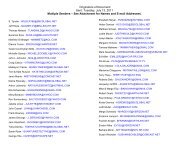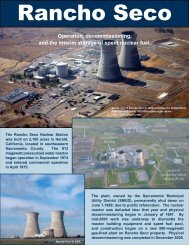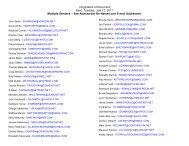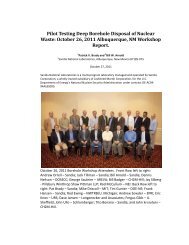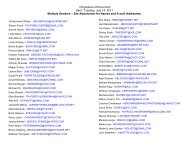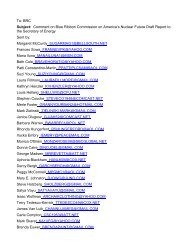Parametric Study of Front-End Nuclear Fuel Cycle Costs Using ...
Parametric Study of Front-End Nuclear Fuel Cycle Costs Using ...
Parametric Study of Front-End Nuclear Fuel Cycle Costs Using ...
Create successful ePaper yourself
Turn your PDF publications into a flip-book with our unique Google optimized e-Paper software.
<strong>Front</strong>-<strong>End</strong> <strong>Nuclear</strong> <strong>Fuel</strong> <strong>Costs</strong><br />
metal. If the RepU is going to be processed immediately into RepU fuel, it will generally be<br />
converted to UF 6<br />
or UO 2<br />
, depending upon the type <strong>of</strong> fuel being manufactured. 8<br />
RepU Conversion and Processing: The process to convert RepU that was stored as U 3<br />
O 8<br />
into<br />
RepU UF 6<br />
(Rep-UF 6<br />
) for use as feed material for uranium enrichment is the same process used to<br />
convert natural uranium. The chemical impurities in RepU are removed during the conversion <strong>of</strong><br />
UF 4<br />
into Rep-UF 6<br />
and further purification occurs during the transfer <strong>of</strong> Rep-UF 6<br />
between<br />
containers. 9<br />
This purification process is important as the Rep-UF 6<br />
must meet the ASTM product<br />
specifications for Rep-UF 6<br />
and for LEU fuel. 10<br />
RepU Enrichment: The process to enrich Rep-UF 6<br />
is the same as that used to enrich natural UF 6<br />
.<br />
However, due to the higher radiation level in Rep-UF 6<br />
, dedicated processing facilities are<br />
typically used in order to be able to provide additional radiation protection. As discussed in<br />
IAEA (2007), radiation levels during the enrichment process can be reduced by minimizing the<br />
time between conversion and enrichment <strong>of</strong> RepU and purifying the Rep-UF 6<br />
immediately prior<br />
to shipment for enrichment. As noted earlier, in order to achieve the same burnup levels that can<br />
be achieved by LWR fuel made from natural uranium, the EUP from RepU must have a higher<br />
235<br />
U assay in order to compensate for the presence <strong>of</strong> neutron-absorbing 236 U. The 235 U assay in<br />
RepU can vary from 0.60 w/o (lower than that <strong>of</strong> natural uranium) to as much as 1.1 w/o 235 U<br />
(higher than that <strong>of</strong> natural uranium). Thus, when RepU has 235 U assays that are depleted relative<br />
to natural uranium, additional SWU are required. When RepU has 235 U assays that are enriched<br />
relative to natural uranium, fewer SWU would be required. This variability is an important<br />
factor in determining the economics <strong>of</strong> RepU use.<br />
RepU UO 2<br />
<strong>Fuel</strong> Fabrication: The enriched Rep-UF 6<br />
is converted to solid UO 2<br />
and fabricated into<br />
fuel using the same manufacturing process as used for fuel made from natural uranium. For UO 2<br />
fuel made from Rep-UF 6<br />
, the fuel fabrication process requires additional worker radiation<br />
protection. The time between the delivery <strong>of</strong> enriched Rep-UF 6<br />
for fuel fabrication and the<br />
conversion into RepU UO 2<br />
is generally as short as possible in order to reduce radiation doses due<br />
to the 232 U daughters. <strong>Fuel</strong> fabrication lines generally include additional radiation shielding and<br />
automated processes may be utilized that are not normally employed for the fabrication <strong>of</strong> fuel<br />
from NatU. 11<br />
1.3 Uranium Requirements for an Individual <strong>Nuclear</strong> Power Plant<br />
<strong>Nuclear</strong> fuel cycle design relationships associated with planned discharge burnup, reload 235 U<br />
assay, cycle effective full power days (EFPD) energy production, and core reload fraction that<br />
were developed in EPRI Report 1018574 may be combined with the fundamental equations<br />
governing uranium and separative work to determine the front end fuel cycle requirements for an<br />
individual nuclear power plant. Representative physical parameters for a typical U.S. PWR are<br />
presented in Table 1-1 and are used in this study.<br />
8<br />
9<br />
10<br />
11<br />
IAEA (2007), p. 18, p. 28.<br />
IAEA (2007), pp. 30-31.<br />
IAEA (2007), pp. 28-29.<br />
IAEA (2007), pp. 45-46.<br />
1-5


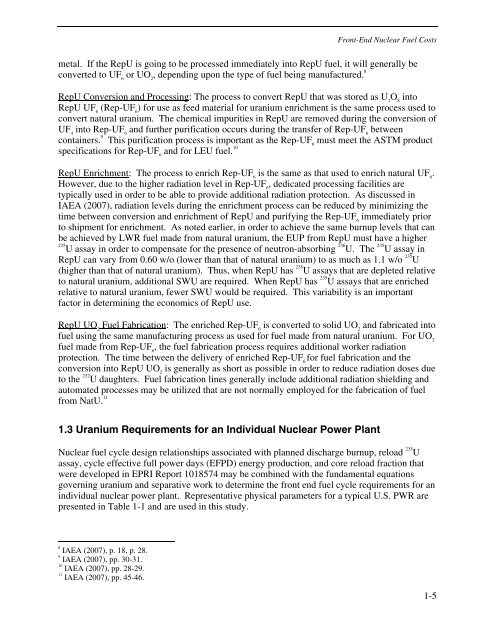
![Rainer Schottlaender[SMTP:RAINER.SCHOTTLAENDER@WEB.DE]](https://img.yumpu.com/51418350/1/190x245/rainer-schottlaendersmtprainerschottlaenderwebde.jpg?quality=85)
